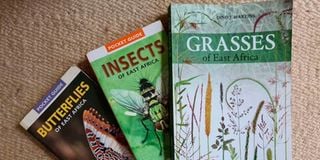Dino Martins’ new book on grasses

A selection of Dino Martins books.
Occasionally, my Dad, John, receives a request from Struik Nature publishers to review a new book. He has done them on birdcalls and even trees, but when a new book on grasses came out the other day, he wasn’t sure where to begin.
I have actually been keenly waiting for this particular book to be published, so I was happy to get my hands on a copy.
Grasses are arguably the most successful plant family on the planet and we, as humans, rely on them for countless reasons. We have domesticated dozens of species into thousands of varieties, not least as crops and livestock fodder and, in doing so, we have taken them across the globe. Sir David Attenborough once intimated that perhaps grasses have exploited us to help them be so prosperous!
As a tour operator and safari guide, I might have a few more uses for such a book than most, but it is still a really niche subject to go on about with guests. However, the importance of grasses cannot be understated, and virtually every safari tourist to Kenya interacts with these plants in some way.
Until now, other than a few truly academic and unwieldy books, anyone interested in the identification of our region’s grasses has had to rely on Southern African field guides that often don't feature the local species or relevant habitats.
Highland savannahs
This new book, Grasses of East Africa by Dr Dino Martins, the Kenyan entomologist and Director of the Mpala Research Centre, features 100 common or ecologically important species – from the low-lying coastal belt to semi-arid scrublands, highland savannahs, and up to the alpine ecosystems in our mountainous areas. For the purposes of the book, East Africa is defined as Kenya, Tanzania, Uganda, Rwanda and Burundi.
Dino’s book is certainly not just for safari guides, rangeland ecologists or botany enthusiasts, though. It features interesting and detailed introductory sections on grass ecological and economic importance along with habitat maps and well-illustrated pages on how to go about using the book for identification. The account of each species has good information, great photographs, and lovely hand-drawn illustrations.
In anticipation of writing this article, I have carried the book around with me for the last three weeks. In that time, I have been up to 12,000 feet on Mount Kenya, and up to the Barsalinga Plains in Samburu, between the Karisia Hills and Mount Nyiro.
Bamboo
Unfortunately, the rains had only just (finally!) started falling in northern Kenya, so mature grasses were few and far between up there, but on Mount Kenya I was able to use the book to identify and learn a bit more about the Tussock and Bamboo species I saw on my journey. I look forward to soon taking it with me on a trip to Tsavo toward the end of the month, where the April rains will have brought the grasses to life. It will come into its own in the Maasai Mara and Laikipia, when I am there in July and August.
For too long, Kenya and East Africa have lacked decent and accessible field guide resources for subjects other than, perhaps, birds and mammals. Over the last few years – thanks to individuals such as Dino, with his insect, butterfly and now grass books and organisations such as Struik Nature – that is beginning to change.
Grasses of East Africa is being sold at BookStop in the Yaya Centre and other leading book shops. Its price is Sh2,700.
Andreas Fox is Managing Director at Mbweha Training and Trails





